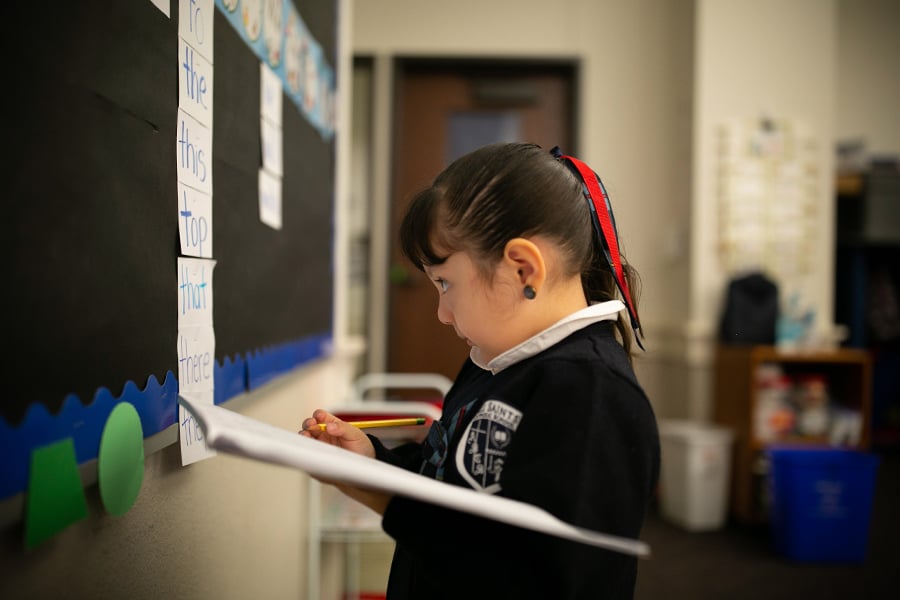Bilingual education boosts capabilities, confidence for All Saints students

Analeah Bedolla studies some words on the board as kindergarten students at All Saints Catholic School learn lessons in Spanish and English in a bilingual classroom, Wednesday, October 24, 2018. (NTC/Rodger Mallison) Click for
FORT WORTH — Isabella and Mia Rodriguez are learning at a young age that being bilingual makes it easier to help others.
Mom Leticia Rodriguez said her daughters can help their grandmother when they go to stores.
“I see them now helping people talk to my mother who is not bilingual,” Rodriguez said. “They’ll start translating for her when she asks, ‘What are they saying?’”
Isabella, a second grader, and Mia, a kindergartner, are gaining a strong education in both Spanish and English thanks to the dual language program at All Saints Catholic School.
Now in its fourth year, the program includes classrooms from pre-kindergarten three-year-olds through second grade. Each year, school officials will add a new grade level, all the way up to eighth grade, said Dr. Arica Prado, the school’s principal.
All Saints began implementing the program in the 2015-16 school year with pre-K three- and four-year-olds as part of the Two-Way Immersion Network for Catholic Schools (TWIN-CS), which is led by educators at Boston College and currently includes 20 Catholic schools around the nation.
The program at All Saints involves alternating days when teachers and students speak Spanish or English, except for certain subjects. On Mondays, Wednesdays, and Fridays, all instruction — including religion classes, ceremonies, and prayers — is given in Spanish. English is the focus on Tuesdays and Thursdays.
The exceptions are that science and social studies are always taught in Spanish and math is always in English. Language arts is in the student’s home language from pre-K through first grade and bilingual starting in second grade. More than half of the school’s 141 students are in the dual language program.
A 2013 survey to the school’s parents prompted All Saints’ educators to look at bilingual education, Prado said.
“We have two large groups of families wanting Spanish in the classroom. Many are Hispanic families who are the third and fourth generations here, and we were also hearing from our immigrant families,” she said.
Immigrant students were learning English quickly and wanted to stop speaking Spanish at home. Parents who speak English all or most of the time wanted their children to be comfortable in both languages.
Rodriguez said she is bilingual and uses that skill in her work, but her husband’s first language is English, so that was their focus at home. Now she spends time helping her daughters with both Spanish and English.
She especially appreciates the faith aspects of the program.
“I'm really pleased that they’re able to pray in both languages,” Rodriguez said. “I hear them sing songs in Spanish, pray in Spanish, and [pray] the Rosary in Spanish.”
Both Servants and Leaders
Kindergarten teacher Angelica Azpeitia said many of her students come in speaking only English while others speak mostly Spanish. She pairs up students from different home languages so they can learn from one another.
“There’s a beauty of seeing them help each other and a beauty of how kids are not afraid to say a word wrong,” Azpeitia said. “They really want to try.”

Teacher Angelica Azpeitia gives a high five to a student for a correct answer as kindergarten students at All Saints Catholic School learn lessons in Spanish and English in a bilingual classroom, Wednesday, October 24, 2018. (NTC/Rodger Mallison)
As students grow in their knowledge of the new language, their confidence grows, too.
“Some students have shared how proud they are. Quite a few have grandparents who only speak Spanish,” she said. “When they can say something in Spanish and those grandparents make a party over them saying those words, it makes the children feel great.”
Boston College provides annual summer training for TWIN-CS educators and a year-round mentor who visits the school each week to observe classes, give feedback, and help address challenges.
The dual language education mentor for All Saints is Leticia Chavez, a former bilingual teacher and educator in Fort Worth ISD.
Chavez said, “What was failing in the old bilingual education was we were holding students back by doing everything in their old language and not introducing the new language early enough.”
Prado said that All Saints is drawing in new families because of the dual language program. Students come from 28 different zip codes.
“We were originally a neighborhood school,” Prado said. “Now we’re not just a Northside school, but families are driving in from all over Tarrant County.”
Children in the program are gaining valuable skills to be better global citizens, Prado said.
Azpeitia agreed. Biliteracy gives students an advantage in the workforce and in the community to “be both servants and leaders.”
Learning a new language isn't easy, but the benefits are worth the effort.
“It’s a challenge, but with God everything is possible,” Azpeitia said.
